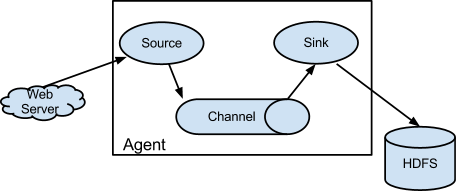Flume概述
Flume is a distributed, reliable, and available service for efficiently collecting(收集), aggregating(聚合), and moving(移动) large amounts of log data.
设计目标
业界同类产品对比
- Flume: Cloudera/Apache Java
- Scribe: Facebook C/C++ 不再维护
- Chukwa: Yahoo/Apache Java 不再维护
- Fluentd: Ruby
- Logstash: ELK(Elasticsearch,Kibana)
Flume架构及核心组件

- Source 收集
- Channel 聚集
- Sink 输出
Flume环境部署
前置条件
- Java Runtime Environment - Java 1.8 or later
- Memory - Sufficient memory for configurations used by sources, channels or sinks
- Disk Space - Sufficient disk space for configurations used by channels or sinks
- Directory Permissions - Read/Write permissions for directories used by agent
安装jdk
下载解压到~/app
将java配置到系统环境变量中:vi ~/.bash_profile
1
2
3
| export JAVA_HOME=/root/app/jdk1.8.0_191
export PATH=$JAVA_HOME/bin:$PATH
source ~/.bash_profile
|
检测:java -version
安装Flume
下载解压到~/app
将flume配置到系统环境变量中:
1
2
3
| export FLUME_HOME=/root/app/apache-flume-1.6.0-cdh5.7.0-bin
export PATH=$FLUME_HOME/bin:$PATH
source ~/.bash_profile
|
flume-env.sh的配置:export JAVA_HOME=/root/app/jdk1.8.0_191
检测:flume-ng version
Flume实战
需求1:从指定网络端口采集数据输出到控制台
使用flume的关键就是写配置文件:
- 配置source
- 配置channel
- 配置sink
- 把以上3个组件串起来
配置文件
1
2
3
4
5
6
7
8
9
10
11
12
13
14
15
16
17
18
19
20
21
22
23
24
25
26
27
28
29
| # example.conf: A single-node Flume configuration
# a1:agent名称
# r1:source名称
# k1:sink名称
# c1:channel名称
# Name the components on this agent
a1.sources = r1
a1.sinks = k1
a1.channels = c1
# Describe/configure the source
a1.sources.r1.type = netcat
a1.sources.r1.bind = localhost
a1.sources.r1.port = 44444
# Describe the sink
a1.sinks.k1.type = logger
# Use a channel which buffers events in memory
a1.channels.c1.type = memory
# a1.channels.c1.capacity = 1000
# a1.channels.c1.transactionCapacity = 100
# Bind the source and sink to the channel
a1.sources.r1.channels = c1
a1.sinks.k1.channel = c1
|
启动agent
1
2
3
4
5
| flume-ng agent \
--name a1 \
--conf $FLUME_HOME/conf \
--conf-file $FLUME_HOME/conf/example.conf \
-Dflume.root.logger=INFO,console
|
使用telnet进行测试:telnet localhost 44444
1
| Event: { headers:{} body: 68 65 6C 6C 6F 0D hello. }
|
Event是Flume数据传输的基本单元
Event = 可选的header + byte array
需求2:监控一个文件实时采集新增的数据输出到控制台
Agent选型:exec source + memory channel + logger sink
配置文件
1
2
3
4
5
6
7
8
9
10
11
12
13
14
15
16
17
18
19
20
21
22
23
24
| # example.conf: A single-node Flume configuration
# Name the components on this agent
a1.sources = r1
a1.sinks = k1
a1.channels = c1
# Describe/configure the source
a1.sources.r1.type = exec
a1.sources.r1.command = tail -F /root/data/data.log
a1.sources.r1.shell = /bin/bash -c
# Describe the sink
a1.sinks.k1.type = logger
# Use a channel which buffers events in memory
a1.channels.c1.type = memory
# a1.channels.c1.capacity = 1000
# a1.channels.c1.transactionCapacity = 100
# Bind the source and sink to the channel
a1.sources.r1.channels = c1
a1.sinks.k1.channel = c1
|
启动agent
1
2
3
4
5
| flume-ng agent \
--name a1 \
--conf $FLUME_HOME/conf \
--conf-file $FLUME_HOME/conf/exec-memory-logger.conf \
-Dflume.root.logger=INFO,console
|
需求3:将A服务器上的日志实时采集到B服务器
技术选型:exec source + memory channel + avro sink
avro source + memory channel + logger sink
配置文件1:exec-memory-avro.conf
1
2
3
4
5
6
7
8
9
10
11
12
13
14
15
16
| exec-memory-avro.sources = exec-source
exec-memory-avro.sinks = avro-sink
exec-memory-avro.channels = memory-channel
exec-memory-avro.sources.exec-source.type = exec
exec-memory-avro.sources.exec-source.command = tail -F /root/data/data.log
exec-memory-avro.sources.exec-source.shell = /bin/bash -c
exec-memory-avro.sinks.avro-sink.type = avro
exec-memory-avro.sinks.avro-sink.hostname = bigdata-01
exec-memory-avro.sinks.avro-sink.port = 44444
exec-memory-avro.channels.memory-channel.type = memory
exec-memory-avro.sources.exec-source.channels = memory-channel
exec-memory-avro.sinks.avro-sink.channel = memory-channel
|
配置文件2:avro-memory-logger.conf
1
2
3
4
5
6
7
8
9
10
11
12
13
14
| avro-memory-logger.sources = avro-source
avro-memory-logger.sinks = logger-sink
avro-memory-logger.channels = memory-channel
avro-memory-logger.sources.avro-source.type = avro
avro-memory-logger.sources.avro-source.bind = bigdata-01
avro-memory-logger.sources.avro-source.port = 44444
avro-memory-logger.sinks.logger-sink.type = logger
avro-memory-logger.channels.memory-channel.type = memory
avro-memory-logger.sources.avro-source.channels = memory-channel
avro-memory-logger.sinks.logger-sink.channel = memory-channel
|
先启动avro-memory-logger
1
2
3
4
5
| flume-ng agent \
--name avro-memory-logger \
--conf $FLUME_HOME/conf \
--conf-file $FLUME_HOME/conf/avro-memory-logger.conf \
-Dflume.root.logger=INFO,console
|
再启动exec-memory-avro
1
2
3
4
5
| flume-ng agent \
--name exec-memory-avro \
--conf $FLUME_HOME/conf \
--conf-file $FLUME_HOME/conf/exec-memory-avro.conf \
-Dflume.root.logger=INFO,console
|
日志收集过程:
- 机器A上监控一个文件,当我们访问主站的时候,会有用户行为日志记录到access.log中
- avro sink 把新产生的日志输出到对应的 avro source 指定的 hostname 和 port 上
- 通过 avro source 对应的 agent 将我们的日志输出到控制台(kafka)
